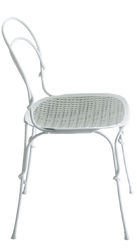MagisDesign Vigna Stacking chair
Vigna Stacking chair
VIGNA STACKING CHAIR
Martino Gamper, 2011
Stacking chair. The steel rod chair Vigna for Magis is Martino Gamper’s first industrial design. Like a climbing plant, the swirl of twisting rod creates a structural feature support the chair leg as well as being a decorative element.
The seat is in bi-injection-moulded plastic, a technology that offers the possibility to obtain a seat in numerous two-tone colour combinations
Alongside the chair, we also developed the design for a number of tables: a round table with a central column of twisted steel rods, and one square four-legged table with the same climbing swirl feature seen on the chair legs.
designer
MARTINO GAMPER
Martino Gamper (born in 1971 in Merano, Italy) lives and works in London.
Starting as an apprentice with a furniture maker in Merano, Gamper went on to study sculpture under Michelangelo Pistoletto at the Academy of Fine Arts, Vienna.
He completed a Masters in 2000 from the Royal College of Art, London, where he studied under Ron Arad.
Working in both design and art venues, Martino Gamper engages in a variety of projects from exhibition design, interior design, one-off commissions and the design of mass-produced products for the cutting edge of the international furniture industry, such as Magis.
Gamper has presented his works and projects internationally in many selected exhibitions, and he was also the recipient of the Moroso Award for Contemporary Art in 2011 and of the Brit Insurance Designs of the Year Furniture Award in 2008 for his project ‘100 Chairs in 100 Days’.
information
USE
Suitable For Outdoor Use
BRAND
Magis Design
MATERIAL
Frame in steel rod, cataphoretically-treated and painted in polyester powder. Seat in bi-injection moulded polypropylene.
DESIGNER
Martino Gamper
YEAR OF PRODUCTION
2011
STRUCTURE
The structure in steel rod painted in polyester powder resembles the branches of a climbing plant that support the seat.
CARE INSTRUCTIONS
We recommend using a soft rag, either dry or wet. When needed, use ph-balanced soap diluted in water. Do not use abrasive sponges as they may leave scratches. Avoid using acidic products, solvents and products containing ammonia. Periodic and correct maintenance allows the product to keep its original aspect and lengthens the duration of its performance.












